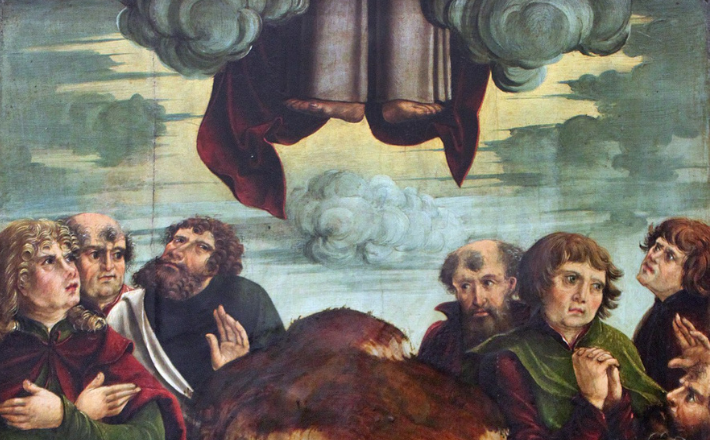Commentary on Ephesians 1:15-23
Prayer is frequently found in Ephesians and placed in “strategic positions within the letter: at the outset, at the transition of the two halves of the letter, and at the end.”1 In this letter, therefore, “theology informs prayer, and prayer itself is the vehicle for theology.”2 Today’s passage, Ephesians 1:15–23, is a great place to look at this intricate relationship between prayer and theology. The author prays for his audience at length in order to reveal the grand vision of God and Christ for the church and the universe.
The author’s prayer is a carefully crafted and elevated speech, rather than spontaneous words. To grasp it fully, one needs to “parse” each sentence, clause, and phrase. The entire paragraph extending from verse 15 to verse 23 is one long sentence with multiple subordinate clauses.3 Beginning with thanksgiving (verses 15–16), the author proceeds to intercessory prayer and requests that God give the audience “a spirit of wisdom and revelation” (verse 17). This prayer for enlightenment (“with the eyes of your heart enlightened,” verse 18a) includes detailed requests:
That they may know
- what is the hope of God’s calling (verse 18b),
- what are the riches of God’s glorious inheritance among the holy ones (verse 18c),
- what is the surpassing greatness of God’s power for believers (verse 19a),
- according to the working of God’s great power (verse 19b).
The author will later turn to “calling” (4:1, 4) and “inheritance” (5:5) in the exhortation section of the letter. In 1:20–21, however, the author focuses on clarifying what he means by “the working of his great power” (verse 19b) with complex sentence structure (verses 20–21).
God’s working of power in Christ is shown by two things:
- raising Christ from the dead and
- seating Christ at God’s right hand in the heavenly places (verse 20),
- (seating him) above all natural and supernatural beings in this age and the age to come (verse 21).
In other words, Ephesians 1:20–21 conveys an idea similar to the second half of the Christ hymn in Philippians 2:9–11. In Ephesians 1:22a, the author goes on to quote Psalm 8:6, “[God] has put all things under his [presumably, Christ’s] feet,” as a christological summary. This quotation is reminiscent of 1 Corinthians 15:25–28, but the author of Ephesians transposes this cosmic subjugation of all things into the present reality.4 In the present, God has subjugated all things to Christ’s authority.
This high Christology has significant bearing on the church. The author continues: God “has made [Christ] the head over all things for the church, which is his body, the fullness of him who fills all in all” (verses 22b–23). This wording is similar to Colossians 1:17–19.
- Colossians 1:17–19 “[Christ] himself is before all things, and in him all things hold together. He is the head of the body, the church; … For in him all the fullness of God was pleased to dwell.”
- Ephesians 1:22b–23 “[God] has made [Christ] the head over all things for the church, which is his body, the fullness of him who fills all in all.”
A closer look reveals they have distinctive points of emphasis. Like Ephesians, Colossians talks about all things (ta panta), but for Colossians, the emphasis is on how all things are sustained and reconciled in Christ. Furthermore, Colossians identifies Christ as the head of the church, but in Ephesians, Christ’s headship is over all things, not only the church. As the body of Christ, the church received this “head of all things” as a glorious gift.
On Ascension Day, the prayer in Ephesians 1:15–23 encourages Christians to broaden their perspective (“the eyes of our heart”) regarding the Lord’s ascension. That the risen Christ has ascended means that he now reigns over the entire universe, despite the author’s world being dominated by Roman imperial power, and the modern world by different super-powers. The author declares that Christ “ascended far above all the heavens, so that he might fill all things” (4:10). Christ cannot be restricted within church walls, nor should Christ’s light be under a bushel basket, because the church is part of ta panta, all things, which Christ rules over as cosmic head. In Christ all are deeply connected (4:16) in one hope (4:4).
As Cindy Rigby notes, “The doctrine of the ascension reminds us to think about living lives that refuse to give up on the hope that bodies are related to one another and that the world, therefore, can be transformed.”5
With the author of Ephesians, who is a master of prayer, we pray that the church, and the individuals in it, can see the exalted Christ with the enlightened eyes of their hearts. In this Christ, God permeates and transforms all things, bodies, lives—human and nonhuman. At the end of the world, “we will all be transformed” (1 Corinthians 15:50, my translation), but this has already begun with Christ. “So if anyone is in Christ, there is a new creation: everything old has passed away; look, new things have come into being!” (2 Corinthians 5:17, New Revised Standard Version Updated Edition).
Notes
- Gregory E. Sterling, “Prayer as Theological Reflection: The Function of Prayer in Ephesians,” Empsychoi Logoi—Religious Innovations in Antiquity, ed. Alberdina Houtman et al. (Leiden: Brill, 2008), 568.
- Luke Timothy Johnson, The Writings of the New Testament: An Interpretation, 3rd ed. (Minneapolis: Fortress, 2010), 364.
- NA28 (the standard critical edition of the Greek New Testament) presents verse 20 as the beginning of a new sentence. Yet, verse 20 is closely connected with verse 19 by a relative pronoun in verse 20 (hēn), which suggests that the previous sentence continues. This feminine singular relative pronoun in verse 20 could refer to any feminine noun (dynamis/power, energeia/working, or ischys/strength) in verse 19. I understand energeia (working) to be the antecedent, but other nouns would also make sense because Ephesians emphasizes core ideas by piling up similar words and phrases (pleonasm).
- It needs to be mentioned that the alleged gap between the undisputed Pauline letters (for example, 1 Corinthians) and the disputed Pauline letters (for example, Ephesians) in terms of eschatology (future eschatology versus realized eschatology) would not be narrower than previously supposed. See, for example, L. Ann Jervis, Paul and Time: Life in the Temporality of Christ (Grand Rapids: Baker Academic, 2023), which argues for a completely renewed temporality in Christ for those in Christ.
- Cynthia L. Rigby, Holding Faith: A Practical Introduction to Christian Doctrine (Nashville: Abingdon, 2018), 273.



May 29, 2025